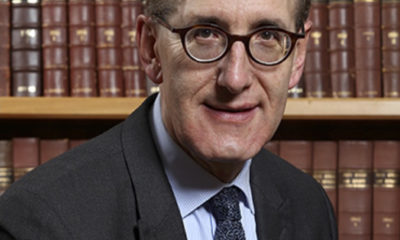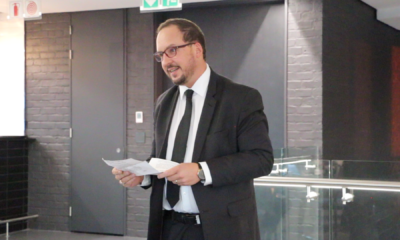
OpEds

Pretoria’s Old Synagogue: from simcha to shande
On a recent visit to Tshwane, I was horrified to see the dilapidated state of the Old Synagogue on Paul Kruger Street in the city centre, which is a heritage icon for Jews and South Africans.
So many happy recollections of weddings, Bnei mitzvah, and Brit Milahs flooded my memory, and my eyes filled with tears. I thought of the significance of this majestic building that witnessed the start of the Rivonia Treason Trial of 1960 and 1964, as well as the inquest into the death of Steve Biko.
Today, the building lies in ruins, designated to the ash heap of a bygone era. The pain in my chest was acute as I looked at this wonderful monument that has been vandalised and abused instead of being cherished and preserved for generations to come.
As part of my oversight visits to buildings owned by the department of public works and infrastructure, I was asked by Councillor Wayne Helfrich and Candidate Councillor Leanne de Jager to come to Tshwane to investigate a number of heritage buildings. The belief was that while they had all been abandoned, they could be repurposed and reused.
It’s of the utmost importance that buildings such as this magnificent shul should be preserved at all costs to tell the stories of a bygone era. It needs to serve as a reminder of the tremendous impact it played as a catalyst to the birth of democracy in South Africa.
The first stone of the Old Synagogue was laid in 1897, and the shul was consecrated on 20 August 1898, making it the first permanent shul in Pretoria.
As a result of the end of the Anglo-Boer War in 1902, the community had financial constraints. In 1906, legendary philanthropist and businessman Sammy Marks settled the mortgage of the shul, and donated it back to the community. He had three strict instructions:
- The property couldn’t be sold, ceded, or assigned to anyone, but was to be used exclusively for a shul in perpetuity;
- No mortgages, charges, or encumbrances could be applied or laid on the property; and
- The house on the property could be used only as the residence of the minister of the congregation (rabbi) or some official of the shul.
What would Sammy Marks be thinking today? He and his descendants would be horrified if they stood where I stood and saw – and smelled – the destruction that greeted us when we entered the building.
I can still feel the heaviness in my heart as I gazed up at the once ornate, beautiful ceiling and the galleries that had held so many faces smiling down on the simchas that marked this building’s history.
But the building wasn’t just a source of joy and miracles. In 1952, the growing Jewish community moved to another building in Pretorius Street, taking its Aron Kodesh, menorah, cornerstone, and stained-glass windows with them to their new home that could accommodate increasing numbers.
The site was then expropriated and transferred to the state with the intention of redeveloping the entire block on which the shul stood into a new Supreme Court.
In 1958, it was modelled as an annex of the Supreme Court for security-related cases. The striking sandstone façade of the building was neutralised by painting it cream. Two utility buildings for police accommodation, holding cells, and witness waiting rooms were added.
This further dehumanised this once magnificent vestige of Jewish life in Pretoria. These utility buildings were created with strict racial segregation, another painful reminder of our tragic past.
The area of the Aron Kodesh and bimah were converted into judicial benches, windows, were bricked up, the Magen David replaced by the South African coat of arms, and the seating converted to that of a conventional court.
The neshomah of the shul was removed in its entirety, but it started to have importance in our democratic life. The first treason trial was transferred to this holy building on 1 August 1958, and lasted until 29 March 1961.
Those who made their appearance in this building in the two treason trials (of 1958 and 1962) included Nelson Mandela, Walter Sisulu, Govan Mbeki, Elias Motsoaledi, Andrew Mlangeni, and my late uncle, Denis Goldberg. Their sentencing in the infamous Rivonia Trial, however, took place in the Palace of Justice.
During the trial, one of the witnesses, M Mkalipe, brought his Bible into the witness box. To the surprise of the judges seated where the rabbi used to stand, Mkalipe read a few verses from the book of Daniel to his “assembled congregation”. He said he did it deliberately to invoke the rich history of the Old Synagogue – a religious space distinct from the Calvinist Dutch Reformed roots of the apartheid regime.
“We cannot allow such a magnificent, significant, and authentic piece of our history as Jews and as South Africans to disappear,” says Helfrich. “We have to come together as a community to restore this once great symbol to its former glory. The Jewish community in Tshwane has expressed a deep sense of sadness at the demise of the building, and would love to see it restored as a Jewish and major South African heritage site.
“So many promises have been made to the community that this beautiful home will once again be able to teach and inspire our youth that they have given up hope of them ever seeing the light of day.”
As Jews and South Africans, we need to change this. We need to restore hope that history has a place in our lives, that we can continue to celebrate the rich heritage that is housed in this building, and that we can free the voices that once rang out in this shul so that they can speak to us again.
Perhaps the South African Jewish Board of Deputies in conjunction with the Tshwane Jewish community can breathe life into this Grand Old Dame of Jewish heritage. Let’s mobilise and make a difference. Let’s revive this legacy, and let it be a historic museum, a testimony to the past, and an inspirational teaching space for generations to come.
- Madeleine Hicklin is the Democratic Alliance shadow deputy minister: department of public works and infrastructure.











Lawrence Nowosenetz
March 25, 2021 at 1:25 pm
The Pretoria Council of the SAJBOD made exhaustive efforts to restore the Old Syagogue with the Department of Arts and Culture and to covert it into a museum. Such arich history. No one was interested. The lauder Foundation was also approached without success. Any ideas?
Troy
March 25, 2021 at 7:56 pm
I was inside that synagogue about a month ago. I took some pics. Very sad to see how it has been neglected.
Daniel
November 6, 2024 at 4:57 pm
What need to do to visit the boildinv